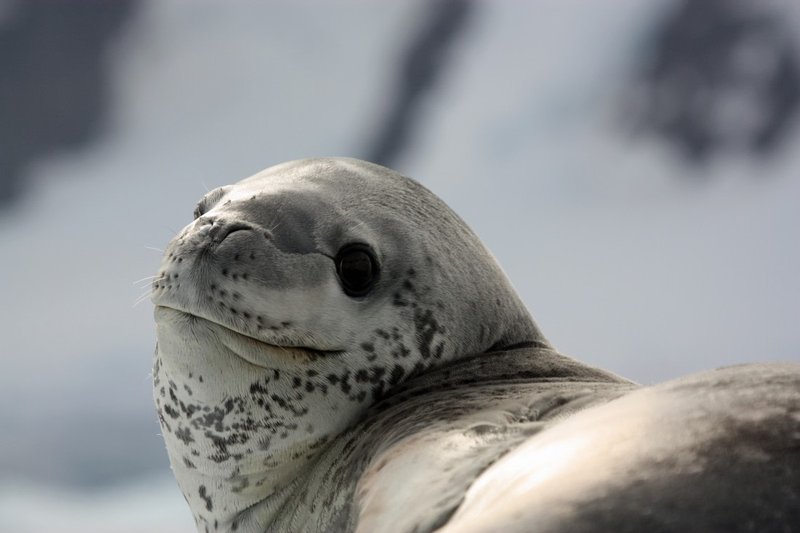
Leopard seals are impressive hunters, known for their unique spotting and strong jaws. While they generally aren’t aggressive toward humans, interacting with them still requires caution, much like meeting a new dog that seems friendly but could react unpredictably. So, let’s dive into the world of leopard seals and explore how we can appreciate these magnificent animals from a safe distance.
What Is a Leopard Seal?
Leopard seals are one of the largest members of the phocid family, often reaching lengths of up to 10 feet. You could think of them as the “big cats” of the seal world, as their spotted coats resemble the fur of leopards. Found mainly in the cold waters of the Antarctic, these seals are equipped for hunting. Their diet primarily consists of krill, fish, and even other seals.
With their powerful bodies and robust jaws, leopard seals are considered apex predators in their habitat. They’ve adapted to thrive in icy waters, using their strength and agility to catch prey. Their unique vocalizations and social behaviors have made them a topic of fascination among marine biologists. As beautiful as they are intimidating, these seals present a mix of charm and danger that raises the question: how should humans approach them?
Are Leopard Seals Dangerous to Humans?
Here’s the thing: leopard seals generally aren’t aggressive toward humans. Accidents, though rare, can happen. These seals can be unpredictable, and what might seem like playful behavior can quickly turn serious. There have been reports of leopard seals engaging in curious interactions with divers, some of whom have experienced unintentional aggression.
It’s crucial to remember that these animals are wild. Their natural instincts can kick in, especially if they feel threatened or cornered. Just imagine a dog startled by a sudden movement. They may react without thinking, which could lead to a bite or a chase. This isn’t to say leopard seals will attack, but it’s always smart to maintain a safe distance and observe their behavior from afar.
How to Safely Observe Leopard Seals
Want to catch a glimpse of these magnificent creatures? Here are some tips to keep your interactions safe and enjoyable:
- Keep Your Distance: If you encounter a leopard seal in the wild, maintain a safe distance—ideally at least 100 meters. This gives them the space they need to feel comfortable.
- Use Binoculars: Instead of getting too close, use binoculars for a better view. This way, you can safely enjoy their beauty without disturbing them.
- Join Guided Tours: If you’re seriously interested in observing leopard seals, consider joining a guided tour with experienced professionals who know how to navigate encounters safely.
By following these simple guidelines, you can enjoy the thrilling experience of watching leopard seals without putting yourself or the animals at risk. You might even find a sense of peace in watching them from a distance, appreciating their natural beauty without interfering in their world.
Understanding Leopard Seal Behavior
Getting to know how leopard seals behave can help you figure out how to interact safely. These seals are known for being curious but can also be quite territorial, especially around their haul-out areas—places where they come on land or ice to rest.
Sometimes, you might see them “playing” with objects. They can be intrigued by divers’ bubbles or a camera, which can be charming but also risky. They may approach out of curiosity, and it’s easy for excitement to turn into a more aggressive interaction. Understanding their social cues can help you gauge how they might react.
A relaxed seal will often float quietly or bask on an ice floe. If it feels threatened, however, it may display aggressive postures. This includes launching itself out of the water or making loud vocalizations. Awareness of these signs is vital for anyone hoping to get close to these fascinating animals.
What To Do If You Encounter a Leopard Seal
Encountering a leopard seal can be a thrilling experience, but knowing how to react is essential. Here’s a quick checklist to keep in mind:
- Stay Calm: If you spot a leopard seal, breathe and remain calm. Sudden movements can startle them.
- Back Away Slowly: If the seal comes closer, back away slowly without turning your back on it. This signals that you’re not a threat.
- Observe from a Distance: Always prioritize observation over interaction. It’s best to enjoy the moment while maintaining a safe distance.
In situations where you feel uncomfortable or if the seal shows signs of aggression, it’s best to leave the area. Remember, you’re a guest in their environment, and respecting their space is crucial for both your safety and their well-being.
Conservation and Respect for Leopard Seals
Conservation plays a massive role in how we interact with leopard seals. Their populations face threats from climate change, habitat loss, and pollution. As people who enjoy wildlife, it’s our responsibility to support conservation efforts and promote respectful interactions.
By advocating for these amazing animals, we can help ensure future generations continue to appreciate them. Support organizations focused on marine conservation, and consider how your activities may influence wildlife.
Understanding the balance between human curiosity and animal safety is crucial. The more respect we show for their habitats and behaviors, the better chance there is for a harmonious coexistence.
In conclusion, interacting with leopard seals can be a thrilling adventure, but it requires a great deal of respect and understanding. While they aren’t inherently dangerous, wild animals can behave unpredictably. By keeping a safe distance, observing their behaviors, and prioritizing their well-being, we can enjoy these incredible creatures without compromising our safety or theirs.
So, next time you think about heading to their icy habitat, remember to pack your binoculars and a respect for their space. After all, there’s nothing quite like witnessing the beauty of a leopard seal in its natural environment – just make sure you do it safely!

